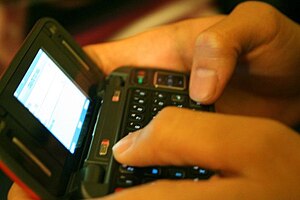Number of SMSs ÷ Mobile Subscribers > Number of Calls ÷ Subscribers
 Image via Wikipedia
Image via Wikipedia
SMS is a text-only message delivery system on mobile phone networks. As a compliment to voice calls, text messages travel through the wireless service provider’s network, routed and delivered much like a voice call. The messaging server for SMS or text messaging routes all messages to the appropriate mobile phone or application based on the number in the destination address (source: CTIA).
Nowadays, SMS has gone far beyond people-to-people (aka person-to-person or human-to-human) communication. From an interactions perspective, the communication path can fall into the following categories: person-to-person (P2P), person-to-machine (P2M), application-to-person (A2P) and machine-to-machine (M2M). I will talk more about that in another post.
Reaching the incredible mark of 4.5 Trillion SMS text messages sent in 2009 and 3.6 Billion users (source: Tomi Ahonen, 2010), out of over 5 billion mobile phone connections worldwide mobile phone, is by far the most versatile, ubiquitous, prolific and successful DATA application in history (i.e., worldwide email user base is 1.4 Billion).
North Americans got into SMS through voting on American Idol, with the Obama presidential campaign of 2008, more recently with the mGive's Red Cross text message fundraising campaign (Text HAITI to 90999) that raised over $37 million for Haiti, the Text4Baby project that provides timely and expert health information through SMS text messages to pregnant women and new moms, and the list goes on and on. Today, more than half of Americans are active users of SMS text messaging and being fast learners; the US average has reached 4 SMS text messages sent per day across the total mobile phone subscriber base. This means the USA has caught up with average European SMS text messaging usage levels.
SMS for development:
There are a growing number of projects taking advantage of the widely available SMS technology to provide practical solutions to communities and to deliver social change. Here is a short list:
- ChildCount+: an mHealth platform developed by the Millennium Villages Project aimed at empowering communities to improve child survival and maternal health. ChildCount+ uses SMS text messages to facilitate and coordinate the activities of community based health care providers, usually community health care workers (CHWs).
- Text to Change: interactive SMS quizzes based on Text to Change's existing SMS platform to get employees to answer questions about HIV/AIDS, and to encourage them to get tested for HIV/AIDS. The pilot ran for four weeks in November and December of 2009, and had an overall response rate of 43%.
- Ushahidi: a platform for map and time-based visualizations of text reports that has been used most prominently in crisis mapping. The first instance of Ushahidi tracked the post-election violence in Kenya in 2007, closely followed by an instance covering outbreaks of xenophobic violence in South Africa in early 2008. Following the Haiti earthquake in early 2010.
- Farmer's Friend (Powered by Google SMS): offers farmers an affordable and targeted way to search for agricultural tips through a SMS-based database. Keywords in the query are matched against the database and the farmer receives a reply with a tip related to his or her query terms.
- Jokko Initiative: Mobile Technology Amplifying Social Change: makes it possible to communicate with a network of people by sending a text message. This means that a nurse, literacy leader, representative of a women’s association, or the village imam can communicate with community members about events or other important activities in the village (for example, a vaccination campaign or a literacy group meeting).
- Happy Pill: uses "flashing" - where you call a number and hang up immediately to "ping" someone. HappyPills takes this basic, essentially binary interaction and applies it to help improve adherence rates for prescription regimens. A medical center can send out flashes to their patients, and the patients are reminded to take their pills and would then flash back to signal that they took their medicine.
